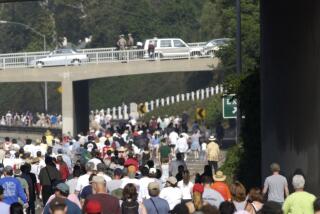Old Trolleys Take Nostalgia Buffs on Trips to the Past
- Share via
SAN FRANCISCO — The Historic Trolley Festival, which began like an understudy called upon to fill the shoes of an incapacitated headliner, now in its fifth season, is a star in its own right.
In the summer of 1983, when San Francisco’s famous cable car system was shut down for a two-year renovation, worried city officials and merchants dreamed up the trolley parade as an alternative for disappointed tourists.
The festival, which now stands on its own as a tourist attraction and also appeals to regular Municipal Railway commuters, began its fifth year May 15 when Mayor Dianne Feinstein piloted Car 1834, “Milan Magic,” down Market Street.
The Italian trolley, built in 1928, is one of a dozen historic streetcars that will take riders on a trip into the past this summer. The most recent addition to the fleet is Car 106, a unique 1912 model streetcar acquired last January as a gift from the Soviet city of Orel.
Most of the foreign streetcars making leisurely summertime trips from the Ferry Building to Castro Street--a round trip of just under seven miles--were donated as gestures of friendship.
History buffs and corporations raised money to obtain and refurbish the streetcars and ship them to San Francisco, the only U.S. city other than New Orleans running the aging cars on a regular basis.
The private sector was primarily responsible for obtaining the cars and getting them into shape, but the Muni, as it is called, spends about $526,000 annually to operate the festival. Muni spokesman Bruce Bernhart said that at least $56,000 is recouped at the fare box.
Joining the foreign cars--which include early 1900s examples of Australian, English, German, Japanese and Portuguese mass transit--are several notable domestic trolleys.
“The Patriarch,” which dates to 1895, is one of the oldest intact streetcars in the world. Modeled after early cable cars, the fragile Car No. 578 is used only on special occasions.
Car No. 1, “Wonderful One,” was the first streetcar used by the Muni, and thus was the first publicly owned streetcar in the United States. First carrying passengers in 1912, it was used regularly until 1951.
Other local favorites are “Sole Survivor,” the only remaining example of 250 cars built for a private San Francisco trolley line in the 1920s; “Reclaimed Wrecker,” a 1914 “tow” streetcar, and three examples of PCC-class cars popular in dozens of cities in the 1930s, ‘40s and ‘50s.
The most popular car among patrons is “Blackpool Boat,” a roofless streetcar from England that resembles a sightseeing boat complete with holiday lights strung from bow to stern.
On sunny days, tourists and residents alike have been known to let car after car pass until the English car, its destination banner proclaiming “Tour of Illuminations,” creaks to a stop.
Although streetcars are similar in appearance to cable cars, they use a pole or pantograph to draw electricity from overhead lines. The older, more romanticized cable cars rattling up San Franciso’s famous hills are dragged along by underground cables.
The Historic Streetcar Festival was not especially difficult to arrange because of a fortuitous, though at the time unpopular, decision to keep intact the Market Street streetcar tracks when light-rail service went underground in 1980.
Line Might Expand
The continued success of the festival could boost plans to expand the line on existing tracks from the foot of Market Street up the Embarcadero.
“We expect to have those plans reviewed and accepted by city officials within 12 months,” Bernhart said.
The rides through history cost the same as a ride on a regular Muni bus or streetcar, 75 cents for adults. Passenger loads on the colorful trolley cars, strangely enough, averaged about the same last summer as those on the historic 8-Market electric bus line, which parallels the streetcar route.
The festival runs daily except Sunday through Oct. 17, with cars every 10 minutes or so from 9:50 a.m. to 5:50 p.m on weekdays and 10:50 a.m. to 6:50 p.m. on Saturdays.
More to Read
Sign up for Essential California
The most important California stories and recommendations in your inbox every morning.
You may occasionally receive promotional content from the Los Angeles Times.













